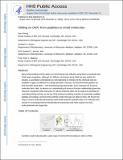| dc.contributor.author | Erwin, Graham S. | |
| dc.contributor.author | Ansari, Aseem Z. | |
| dc.contributor.author | Xiong, Kan | |
| dc.contributor.author | Blainey, Paul C | |
| dc.date.accessioned | 2018-08-27T19:03:49Z | |
| dc.date.available | 2018-08-27T19:03:49Z | |
| dc.date.issued | 2016-07 | |
| dc.date.submitted | 2016-11 | |
| dc.identifier.issn | 14337851 | |
| dc.identifier.uri | http://hdl.handle.net/1721.1/117560 | |
| dc.description.abstract | Many DNA binding proteins utilize one-dimensional (1D) diffusion along DNA to accelerate their DNA target recognition. Although 1D diffusion of proteins along DNA has been studied for decades, a quantitative understanding is only beginning to emerge and few chemical tools are available to apply 1D diffusion as a design principle. Recently, we discovered that peptides can bind and slide along DNA—even transporting cargo along DNA. Such molecules are known as molecular sleds. Here, to advance our understanding of structure–function relationships governing sequence nonspecific DNA interaction of natural molecular sleds and to explore the potential for controlling sliding activity, we test the DNA binding and sliding activities of chemically modified peptides and analogs, and show that synthetic small molecules can slide on DNA. We found new ways to control molecular sled activity, novel small-molecule synthetic sleds, and molecular sled activity in N-methylpyrrole/N-methylimidazole polyamides that helps explain how these molecules locate rare target sites. Keywords: drug delivery; molecular sleds; polyamide; single molecule imaging; small molecule | en_US |
| dc.publisher | Wiley | en_US |
| dc.relation.isversionof | http://dx.doi.org/10.1002/ANIE.201606768 | en_US |
| dc.rights | Article is made available in accordance with the publisher's policy and may be subject to US copyright law. Please refer to the publisher's site for terms of use. | en_US |
| dc.source | PMC | en_US |
| dc.title | Sliding on DNA: From Peptides to Small Molecules | en_US |
| dc.type | Article | en_US |
| dc.identifier.citation | Xiong, Kan et al. “Sliding on DNA: From Peptides to Small Molecules.” Angewandte Chemie International Edition 55, 48 (November 2016): 15110–15114 © 2016 Wiley‐VCH Verlag GmbH & Co. KGaA, Weinheim | en_US |
| dc.contributor.department | Massachusetts Institute of Technology. Department of Biological Engineering | en_US |
| dc.contributor.mitauthor | Xiong, Kan | |
| dc.contributor.mitauthor | Blainey, Paul C | |
| dc.relation.journal | Angewandte Chemie International Edition | en_US |
| dc.eprint.version | Author's final manuscript | en_US |
| dc.type.uri | http://purl.org/eprint/type/JournalArticle | en_US |
| eprint.status | http://purl.org/eprint/status/PeerReviewed | en_US |
| dc.date.updated | 2018-08-27T15:16:42Z | |
| dspace.orderedauthors | Xiong, Kan; Erwin, Graham S.; Ansari, Aseem Z.; Blainey, Paul C. | en_US |
| dspace.embargo.terms | N | en_US |
| dc.identifier.orcid | https://orcid.org/0000-0001-7014-3830 | |
| mit.license | PUBLISHER_POLICY | en_US |
